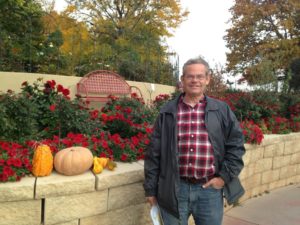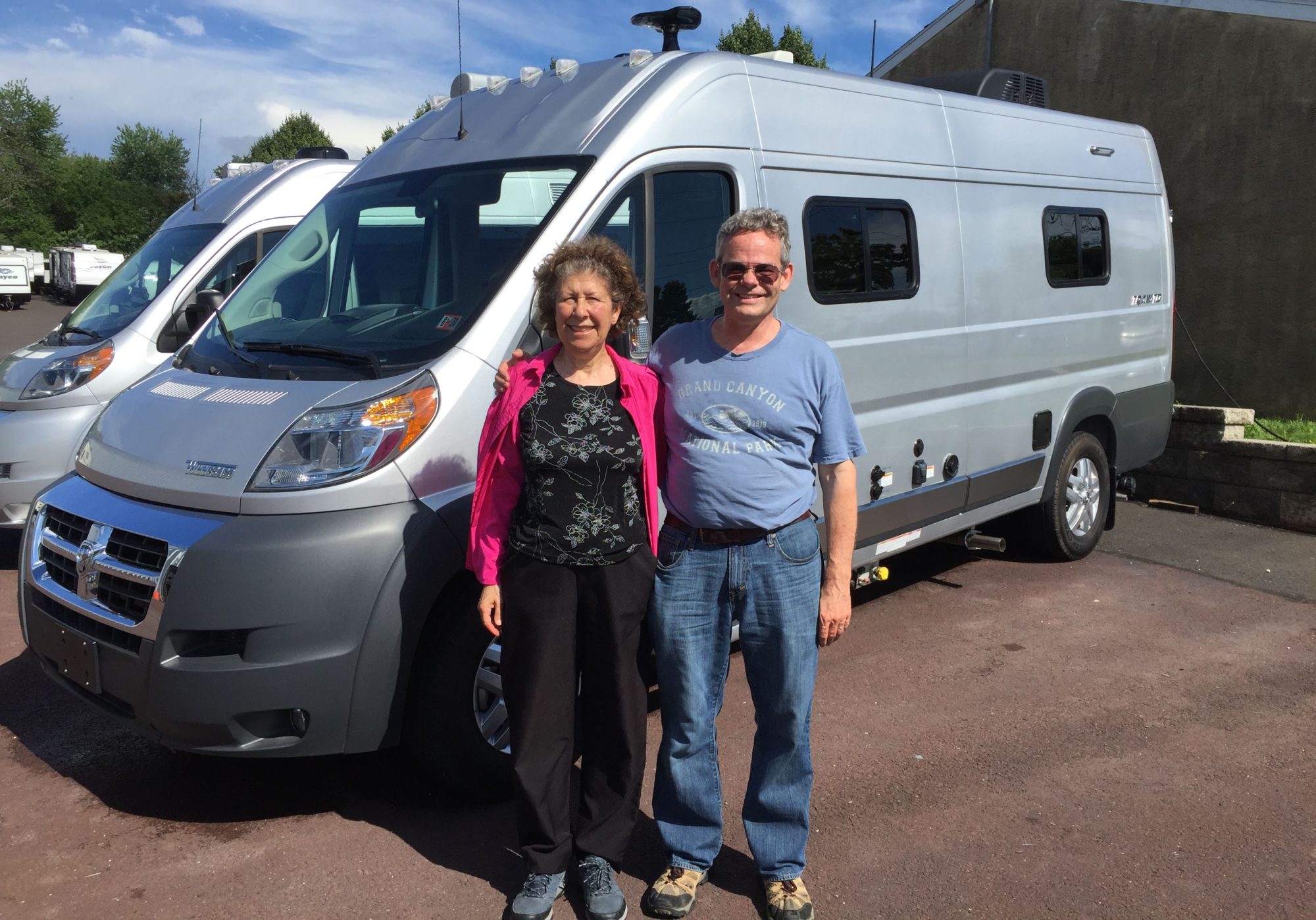Amarillo (Nov.3)
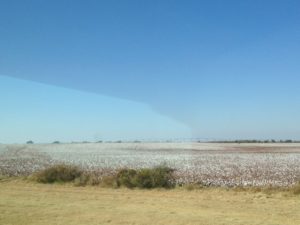 We set off from Oklahoma City at our usual late hour, passing through oil country and a relatively flat landscape. What looked like snowy fields proved to be cotton – lots of cotton. (Read the first few chapters of The Grapes of Wrath to understand some of the ramifications of this.)
We set off from Oklahoma City at our usual late hour, passing through oil country and a relatively flat landscape. What looked like snowy fields proved to be cotton – lots of cotton. (Read the first few chapters of The Grapes of Wrath to understand some of the ramifications of this.)
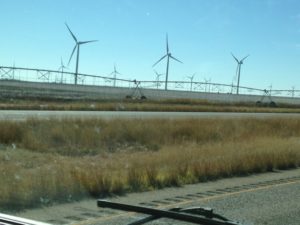
Not surprisingly, given the constant wind, Oklahoma also has a lot of wind farms, which generate about 25% of the state’s power. (However, Texas is the state with the most wind generation at this point in time.)
We pulled into our RV campground in Amarillo in the mid-afternoon. It was recommended to us by our RV neighbors in Oklahoma City, and indeed they pulled in shortly after we did. However, it turned out to be your basic RV parking lot – clean and convenient to the highway, but otherwise not notable.
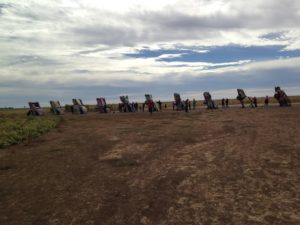
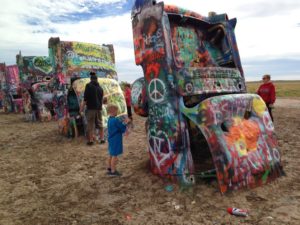 The campground was very close to two of Amarillo’s more bizarre landmarks, which I visited without Chuck the next day. In 1974, a group of hippie artists from California partnered with billionaire Stanley Marsh III, to build a piece of “art” to confound the locals. Cadillac Ranch is a field with 10 Cadillacs half-buried nose down. Much of the exposed parts of the cars have been stolen, but it has become a place of pilgrimage on Route 66 – in fact I first spotted it because of the line of parked cars out in what otherwise appeared to be a corn field. The idea is to come out with one of more cans of spray paint and document yourself (or your kids) spraying graffiti onto what is left of the cars. Since there is a constant trek of visitors, you can expect your artwork to last about 15 minutes before it is covered up by the next visitor. The main trick is to get the photo without getting someone’s spray paint on your camera lens.
The campground was very close to two of Amarillo’s more bizarre landmarks, which I visited without Chuck the next day. In 1974, a group of hippie artists from California partnered with billionaire Stanley Marsh III, to build a piece of “art” to confound the locals. Cadillac Ranch is a field with 10 Cadillacs half-buried nose down. Much of the exposed parts of the cars have been stolen, but it has become a place of pilgrimage on Route 66 – in fact I first spotted it because of the line of parked cars out in what otherwise appeared to be a corn field. The idea is to come out with one of more cans of spray paint and document yourself (or your kids) spraying graffiti onto what is left of the cars. Since there is a constant trek of visitors, you can expect your artwork to last about 15 minutes before it is covered up by the next visitor. The main trick is to get the photo without getting someone’s spray paint on your camera lens.
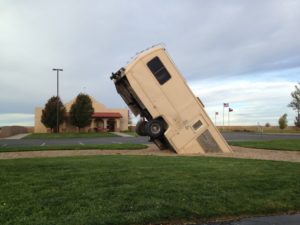 In honor of Cadillac Ranch, our RV park has its own half-buried vehicle.
In honor of Cadillac Ranch, our RV park has its own half-buried vehicle.
Less than a mile away, at a Cadillac dealership, stands the Second Amendment Cowboy – a “Muffler Man” statue in a yellow shirt and cowboy hat.
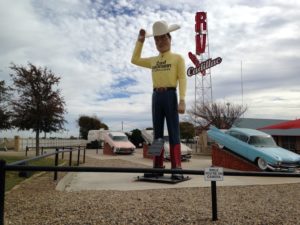 There is a plaque about the Second Amendment (the right to bear arms) and a few names of famous gun-toting actors. Ironically, the Cowboy himself does not have a gun or even a gun belt. Anyways, it is a very Texan concept.
There is a plaque about the Second Amendment (the right to bear arms) and a few names of famous gun-toting actors. Ironically, the Cowboy himself does not have a gun or even a gun belt. Anyways, it is a very Texan concept.
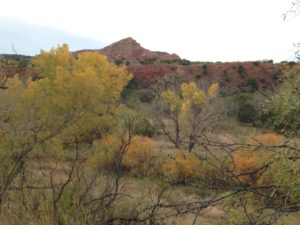
Near Amarillo is Palo Duro Canyon, the 2nd largest canyon in the US and also known as the Grand Canyon of Texas. Unlike the Grand Canyon of Pennsylvania, Palo Duro actually looks like the Grand Canyon, shrunk down to a more human scale. 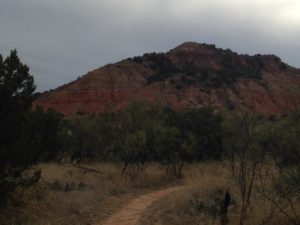 I ended up going twice – once with Rumple but no Chuck (who was tired after driving from Oklahoma City) and once with Chuck but no Rumple (because it is really hot on the canyon floor, and there are too many pricklies for a bootless dog.)
I ended up going twice – once with Rumple but no Chuck (who was tired after driving from Oklahoma City) and once with Chuck but no Rumple (because it is really hot on the canyon floor, and there are too many pricklies for a bootless dog.)
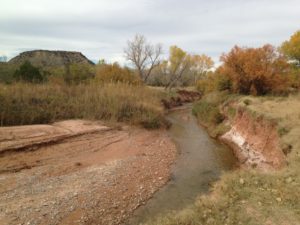 The canyon was carved out by a branch of the Red River, which is just a small creek about 3 feet across when there is no rain.
The canyon was carved out by a branch of the Red River, which is just a small creek about 3 feet across when there is no rain. 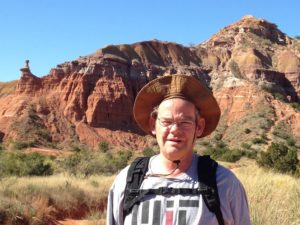 The river is red, because most of the rock is bright red – our cameras are not good enough to get the actual color. The road winds part way around the canyon rim and then descends to the canyon floor, where there are lots of river depth gauges (all starting about 10 feet above the creek during my visit) and flood warnings. The canyon is filled with camp grounds, and we later heard that these frequently need to be evacuated if there has been rain. It certainly looked more like a desert during our visit, except for the cottonwoods near the creek, which are brilliant yellow at this time of year.
The river is red, because most of the rock is bright red – our cameras are not good enough to get the actual color. The road winds part way around the canyon rim and then descends to the canyon floor, where there are lots of river depth gauges (all starting about 10 feet above the creek during my visit) and flood warnings. The canyon is filled with camp grounds, and we later heard that these frequently need to be evacuated if there has been rain. It certainly looked more like a desert during our visit, except for the cottonwoods near the creek, which are brilliant yellow at this time of year.
The white layers in the cliffs are made up of vertical crystals of something – maybe calcite. They are harder than the red rock, which leads to 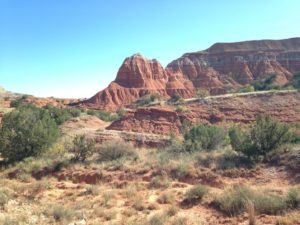
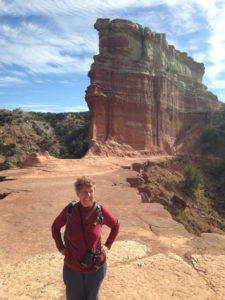
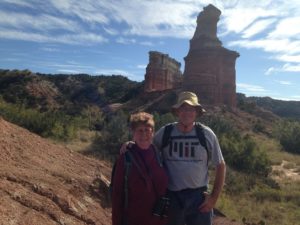
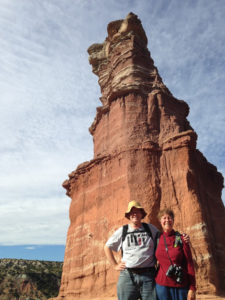 Ω
Ω
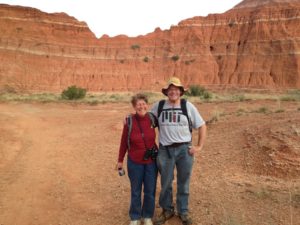 some interesting hoodoos (pillars) where erosion of the underlying rock was impeded by the harder cap.
some interesting hoodoos (pillars) where erosion of the underlying rock was impeded by the harder cap.
The most famous rock formation in Palo Duro is the Lighthouse, seen above to the left. The two narrower pictures are the 2 towers, as seen from the table formation between them. The lower longer tower can easily be climbed, although we opted not to do it.
The Lighthouse is reached via a 3-mile hike. About a mile in, we met a couple from northern Texas – a dentist and his wife (who ran his office) – and walked the rest of the way with them. They were entertaining company and also took some photos of the two of us.
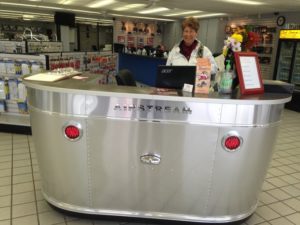 Another attraction in Amarillo is the RV Museum. This is the private project of Jack Sisemore, an Amarillo RV dealer, and one of the founders of Keystone RV (one of the large manufacturers.) The RV showroom has some interesting uses of RV parts, like this sales desk made of an Airstream front end.
Another attraction in Amarillo is the RV Museum. This is the private project of Jack Sisemore, an Amarillo RV dealer, and one of the founders of Keystone RV (one of the large manufacturers.) The RV showroom has some interesting uses of RV parts, like this sales desk made of an Airstream front end.
Mr. Sisemore was an early RV owner, and some of the early models in the museum were ones he bought to use. He also collected motorcycles.
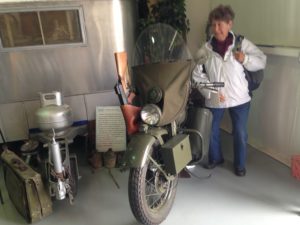
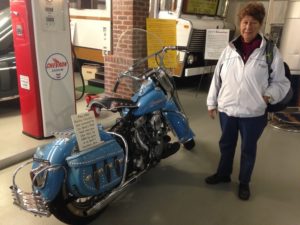 Two of the motorcycles that more interested me were a WW I cycle complete with rifle holster, and the beautifully detailed vanity model below.
Two of the motorcycles that more interested me were a WW I cycle complete with rifle holster, and the beautifully detailed vanity model below.
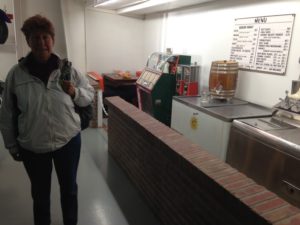 The museum also had this original A&W lunch counter.
The museum also had this original A&W lunch counter.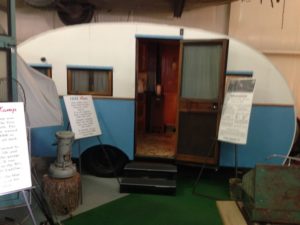
And then, of course, there were the RVs. One of the things that interested me in the museum is that most of the basic designs (except slide-outs) were available from the start – that includes the pop-up tent trailer, the basic pull-trailer with kitchen and the teardrop trailer 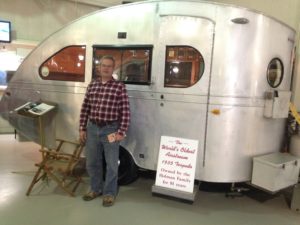
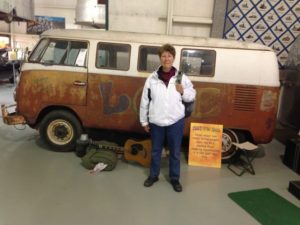 (which has a bed inside and the kitchen in the tail, accessible from outside only). Most of the RVs, even going back to the 1930s, would not look out of place in an RV park today. However, indoor toilets did come a bit later on the scene.
(which has a bed inside and the kitchen in the tail, accessible from outside only). Most of the RVs, even going back to the 1930s, would not look out of place in an RV park today. However, indoor toilets did come a bit later on the scene.
Finally, there were the nostalgia pieces, like the 1960s “love bug” converted VW van, and the bus from the RV movie with Robin Williams.
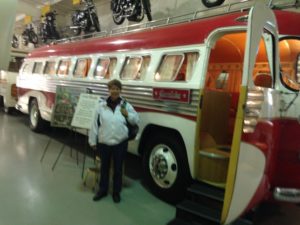
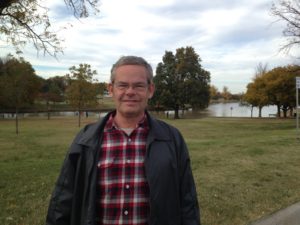 For the afternoon, we went to Medipark. This is a rather large park with a pond and the Amarillo Botanical Gardens, surrounded by the city medical complex, with most of the hospitals.
For the afternoon, we went to Medipark. This is a rather large park with a pond and the Amarillo Botanical Gardens, surrounded by the city medical complex, with most of the hospitals. 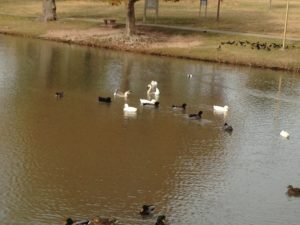 The park is home to hundreds of long-tailed grackles and the pond is full of ducks and geese. We added a lot of duck species to our viewing list, including some domestic varieties which must have escaped into the wild. We also enjoyed the Botanical Gardens, which were still full of blooms.
The park is home to hundreds of long-tailed grackles and the pond is full of ducks and geese. We added a lot of duck species to our viewing list, including some domestic varieties which must have escaped into the wild. We also enjoyed the Botanical Gardens, which were still full of blooms.